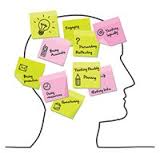Minute-by-Minute Study Strategies
 But is the question-answer strategy really the best way to study? No single way works for everybody, as each child has a different set of strengths and preferences when it comes to internalizing information. Here are some other ways to use this time (also provided as a downloadable PDF to print for your students):
But is the question-answer strategy really the best way to study? No single way works for everybody, as each child has a different set of strengths and preferences when it comes to internalizing information. Here are some other ways to use this time (also provided as a downloadable PDF to print for your students):
1. Flashcards
Turn those questions and answers into flashcards and have your adolescent quiz herself. The simple act of flipping the cards around and putting them into piles of “mastered” and “needs practice” may be enough to keep an active kid moving. Some kids are motivated by timing themselves. Flip those flashcards around, have her read the answer, and try to reproduce the question for a bigger challenge.
2. Categorizing
Use the flashcards to organize the information by categories, put them in some kind of order, or match them up in pairs. The idea is to organize them differently each time so that your student can make more than one connection in his brain for the information.
3. Word combining
Language lovers won’t mind creating sentences with vocabulary. If the test is vocabulary-heavy, start by either writing or speaking the sentences with one word in each and then moving to two words, then three, etc.
4. Song lyrics
Ask a musical or rhythmic adolescent to take the lyrics of her favorite song and rewrite it to include as much of the required information she can. This may take multiple sessions to accomplish, but once it’s done, she can sing it over and over again.
5. Picture notes
During the study session, have a more visual adolescent draw pictures of his notes on flashcards, paper, or a whiteboard, and then describe them.
6. Talk-through
Many adolescents are highly social. If yours is, too, have her go through flashcards or a study guide and explain each aspect in as much detail as possible without reading from the printed information.
7. Picture walk
Have him use the visuals provided in the textbook, online text, worksheets, notes, etc. to explain information either out loud or in writing, depending on his preference.
8. Mnemonic devices
Have her rhyme or create sayings to help her remember information. Creating acronyms or sentences with the first letters of words can also be fun for students who like to play with language.
9. Oral visualization
Read a portion of the notes or worksheet and have your student describe what comes to mind visually.
10. Perspective talk
Talk or write about the material, pretending to be somebody or something else.
11. Superhero letter
Have a word-smart adolescent write a letter to a superhero explaining the material and why the information should be important.
Ultimately, studying comes in dozens of forms, and it’s important to help your adolescent figure out what’s going to work for him or her. Whatever her strengths, whatever his level of comfort, start there. Keep it short. Keep it simple. Keep it painless. And watch what happens when studying becomes a familiar routine — and when students see the fruits of their efforts.
http://www.edutopia.org/blog/good-study-habits-minute-by-minute-heather-lambert
Great advice!